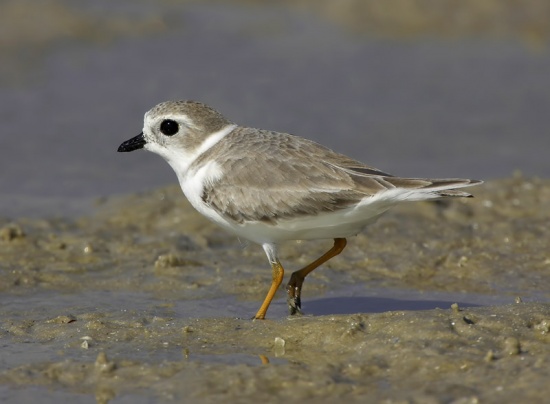- Charadrius melodus
Photographed: Estero Beach, Fort Myers
Identification
A threatened species
The Piping Plover (Charadrius melodus) is a small plover.
The Piping Plover is a sand-colored, sparrow-sized shorebird that nests and feeds along coastal sand and gravel beaches. The adult has yellow- orange legs, a black band across the forehead from eye to eye, and a black ring around the neck during the breeding season. A small plover, often found running then stopping along beaches. Differs from Snowy/Kentish Plover by multiple features. The beak of the piping Plover is orange and blac-tipped, as oppose to the Snowy's/ Kentish's thinner, all-black beak. The Snowy/Kenitsh is also a darker sandy-brown color, and has an incomplete black collar and breastband (which Piping loses in the nonbreeding season, from September to February). Snowy/Kentish also has grayish legs as oppose to piping's orange. Piping also lacks Snowy/Kentish's black cheek patch, but has a more pronounced white supercillium.
Distribution
Their breeding habitat is beaches or sand flats on the Atlantic coast, the shores of the Great Lakes and in the mid-west of Canada and the United States. They are migratory in northern areas and winter on the coasts of the Gulf of Mexico, the southern Atlantic coast of the United States and the West Indies.
Taxonomy
Habitat
Behaviour
They nest on sandy or gravel beaches or sandbars.
These shorebirds forage for food on beaches, usually by sight, moving across the beaches in short bursts. They mainly eat insects, marine worms and crustaceans. It runs in short starts and stops. It is difficult to see when standing still as it blends well with open, sandy beach habitats.
The bird's name is derived from its plaintive bell-like whistles which are often heard before the bird is visible. This bird is endangered and its range has reduced recently due to habitat loss and human activity near nesting sites. Some critical nesting habitat is now protected. In Eastern Canada, the Piping Plover is only found on coastal beaches. In 1985 it was declared an endangered species by the Committee on the Status of Endangered Wildlife in Canada. In 1986 it was declared to be endangered within the watershed of the Great Lakes and threatened in the remainder of its range in the United States.
Often found on beaches that have fences specially erected to protect this threatened bird's habitat from beach-goers on foot or on vehicles. As other Charadrius plovers, often seen running and stopping, as well as bobbing they're head. They live up to their scientific name, melodius, as in the breeding season they are very vocal, making soft whistles and fluttering around near to the ground. They also squabble among other indiviudals.
Comments
I saw some piping plovers on the beach at Galveston Bay, TX. Also some snowy's can be seen.




